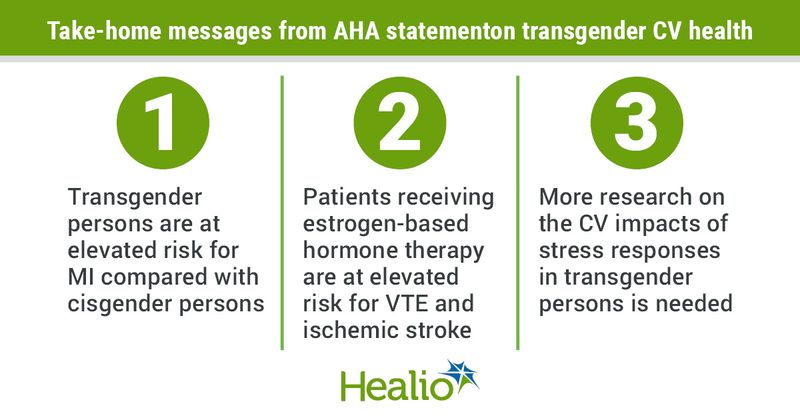AHA: Discrimination, stress may harm transgender CV health, but more data needed
Data on how stigmatization stress responses and gender-affirming hormone therapies may impact the heart health of transgender and gender-diverse individuals are lacking, researchers reported.
In a scientific statement published in Circulation, an American Heart Association writing group reviewed existing research on potential drivers and prevalence of CVD among transgender and gender-diverse individuals and provided recommendations on how to reduce these disparities in clinical research and clinical practice.

The statement was endorsed by the American Academy of Physician Assistants and affirmed by the AMA as having educational benefit.

“Heart health of transgender and gender-diverse people is an important and understudied topic, and it’s critical we highlight what we know and what we need to know about heart health among these populations,” Carl G. Streed Jr., MD, MPH, assistant professor of internal medicine at Boston University School of Medicine, research lead at the Center for Transgender Medicine and Surgery at Boston Medical Center and chair of the writing group for the AHA statement, said in a press release. “Addressing these issues will require a focus on ‘traditional’ risk factors for heart attack and stroke, and a commitment to fight transphobia in order to decrease the additional stress experienced by this population.”
Among transgender and gender-diverse individuals, psychological and physiological stress response associated with stigmatization may manifest as psychosocial, behavioral and clinical CVD risk factors.
CV effects of stress responses
Feelings of stigmatization can be traced to gender-related discrimination, rejection and victimization as well as non-affirmation of gender identity. These variables confer proximal stress factors such as internalized transphobia, negative expectations and concealment, all of which confer poorer mental and physical health in transgender and gender-diverse individuals compared with those whose gender identity is congruent with their sex assigned at birth, Streed and colleagues wrote.
In addition to traditional CV risk factors, psychosocial and physiological stress responses are associated with vascular dysfunction; however, no data exist that describe vascular dysfunction among people who are transgender and gender diverse aside from those studying the effects of gender-affirming hormone therapy, the committee wrote.
As Healio previously reported, a prior AHA statement noted there is a paucity of research and lack of understanding the underlying stressors associated with poor CV health among people who are transgender and gender diverse.
However, the body of data is slowly growing.
Multivariable analyses that used self-reported data form the Behavioral Risk Factor Surveillance System showed that transgender men had an approximately twofold greater prevalence of MI compared with men who are cisgender and a fourfold greater prevalence vs. women who are cisgender. Similarly, transgender women also had a more than twofold increase in prevalence of MI compared with women who are cisgender.
According to the statement, data on the effects of hormone therapy on CV outcomes consistently demonstrate elevated risk for venous thromboembolism and ischemic stroke among transgender and gender-diverse patients receiving estrogen-based hormone therapy. However, evidence was insufficient regarding risk among transgender participants who initiated testosterone-based hormone therapy.
Data from the Behavioral Risk Factor Surveillance System also identified an association between self-reported BMI above 25 kg/m2 among transgender and gender-diverse individuals compared with those who are cisgender (72.4% vs. 65.5%), although studies that evaluated relationships between gender-affirming hormone therapy and BMI showed mixed results. According to the statement, one systematic review of research evaluated testosterone use and BMI in men who are transgender revealed significant BMI increases (1.3% to 11.4%), whereas a longitudinal study in the U.S. that evaluated BMI during a 7-year period did not demonstrate an increase in BMI among men who are transgender.
The writing committee noted that access to gender-affirming surgical interventions often comes with BMI cutoffs and may affect diet, exercise and weight management among transgender and gender-diverse individuals.
Recommendation for clinical practice
The AHA statement offered many recommendations regarding the inclusion of transgender and gender-diverse individuals in CV research, as well as the following recommendations for clinical practice:
- Ensure collection of sexual orientation and gender-identity data in electronic health records.
- Educate health care professionals on disparities faced by transgender and gender-diverse individuals and train for proper assessment of sexual orientation and gender identity in health care settings.
- Incorporate transgender and gender-diverse content in the curriculum of health profession schools and postgraduate training.
- Require continuing education on transgender and gender-diverse health for all practicing clinicians that includes content on CV health disparities.
- Incorporate broader concepts of sex and gender in prediction models for CVD.
“Data specific to transgender and gender-diverse persons lag behind what is needed to understand and improve individual and community heart health. The information available is rapidly improving, though,” Streed said in the release. “This statement summarizes the available evidence showing that addressing traditional cardiovascular risk factors and decreasing stigma-linked stress, together, would improve the heart health of transgender and gender-diverse people. By focusing on the unique issues affecting the well-being of transgender and gender-diverse persons, we have the potential to do better for everyone.”

